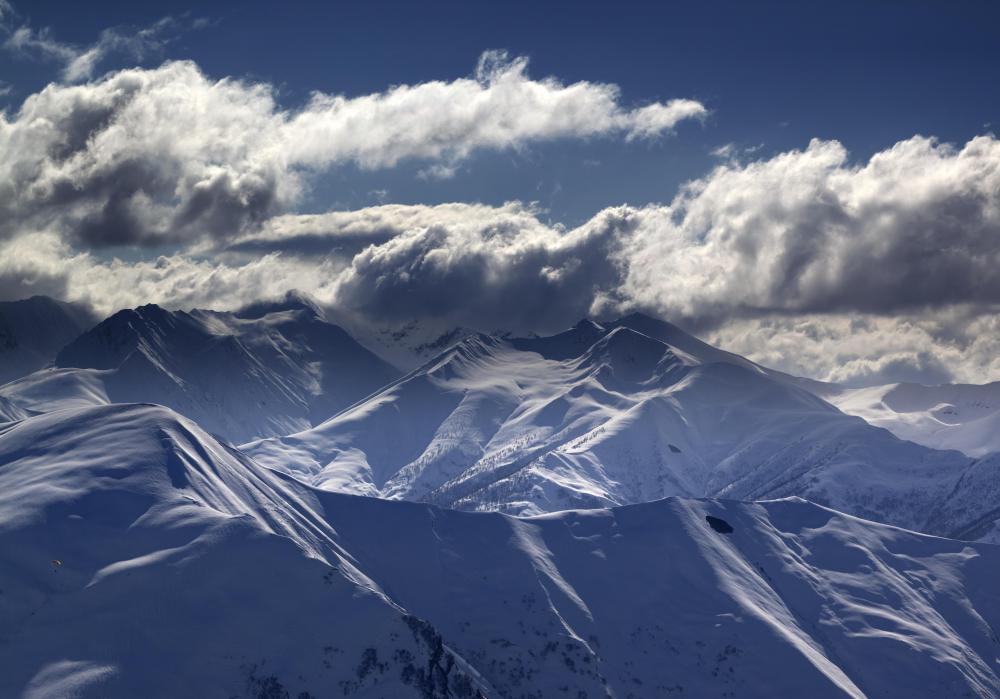Why do Mountains Seem to Attract Clouds?
 Mary McMahon
Mary McMahon
Most observers have noted clouds clinging to mountains, especially famous peaks like Fuji and Kilimanjaro. Mountains also experience more severe weather in the form of rain, sleet, and snow on their windward sides. These landforms do not so much attract clouds as cause them to form, in a well documented meteorological phenomenon. They are, in fact, a very important factor in meteorology — without mountains, the Earth's climate would be very different.
Air currents are constantly traveling across the surface of the Earth, usually in patterns that remain consistent. In the United States, for example, the prevailing winds run West to East. As air travels, it picks up water molecules in vapor form, which remain vaporous in the higher pressure at low elevations. When the air encounters mountains, however, it is forced to rise.

The increase in elevation and drop in pressure cause the water vapor to cool until it reaches the dew point and condenses in the air into water droplets. These droplets are visible as cloud formations. The air may continue to cool and condense until it forms rain or snow, which will fall on the windward side of the mountain. As the cloud sinks along the lee side, the air will warm and the water droplets forming the cloud will turn back into vapor.

This often causes cloud formations to look as though they are stationary and clinging to the peak, because new droplets condense into water as old ones return to a vapor state. These clouds that constantly reform lead people to say that mountains have a pall of cloud at their peaks. This type of cloud is known as an orographic cloud, because it is caused by the forced elevation of an air current by a topographical feature.

Large mountains often form their own microclimates, with extreme variations in weather depending on whether the observer is on the windward or lee side and what the elevation is. Fuji, for example, is famous for being very hot at the base, while still being cold enough to snow at the top. Many people can be endangered by this, because they don't realize the highly changeable weather that occurs around these landforms. When hiking or climbing, it is a good idea for people to research weather conditions over the entire areas so they don't get caught in the cold.
AS FEATURED ON:
AS FEATURED ON:













Discussion Comments
Do the Rocky Mountains have a windward and leeward side? Does this affect the amount of snow that falls on either side of the Rocky Mountains?
@aplenty- That is interesting. I would have never thought that a place like Hawaii would have anything other than a tropical landscape. I have seen pictures of the mountains of Hawaii though, and the forests look beautiful. I have heard that the islands are one of the very few places within the United States where you can see cloud forests. Now I understand why. It takes a high mountain that attracts clouds and moisture to create one of these places.
I used to live on the Big Island of Hawaii, and there is a huge mountain on the island that certainly does create its own micro-climates. The island actually has all of the known micro-climates except arctic and one other (tundra I think). The Mountain, Mauna Loa, is the world's highest mountain if measured from its base below sea level.
The leeward side of the island is completely different from the windward side of the island. On the leeward side of the islands, generally the southeastern side, the islands have a decidedly desert climate. This part of the island is very dry and receives far less rainfall than the windward side.
The windward side of the island is very wet with lush tropical rainforests. This side of the island is beautiful, but can be very wet and humid, especially close to the mountain. On the windward side of the Hawaiian Islands, you will often find that there are beautiful and mysterious cloud forests. There is also a much higher concentration of flora and fauna in the windward environment.
Post your comments